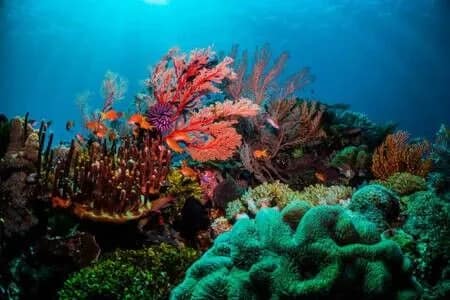Why the real reef begins after you leave the shoreline behind
When most people think of the Great Barrier Reef, they picture vibrant coral gardens teeming with tropical fish, sun-drenched snorkelers, and reef pontoons loaded with tourists. But that version, while beautiful, only scratches the surface. To see the reef’s true spirit – the ever-shifting interplay of color, solitude, and sea – you have to go further. Or rather, you have to stay longer.
Cairns, often labeled as the reef’s tourism capital, is not just a launchpad for half-day snorkels and helicopter flyovers. It’s the beginning of a much more immersive journey, one that requires letting go of land for a few days. Welcome to the world of liveaboard reef diving, where you don’t just visit the reef, you live with it.
Remote reefs and underwater walls you won’t find in brochures.
The Great Barrier Reef is a staggering 2,300 kilometers long, yet most visitors only ever see a sliver of it. Liveaboard vessels based in Cairns change that. These floating eco-hotels take adventurers deep into lesser-known areas like Osprey Reef, Ribbon Reefs, and Holmes Reef, places untouched by the day-tripper circuit.
These Coral Sea dive sites aren’t marked with flags or gift shops. They’re remote, open-ocean gems, often only accessible to those willing to commit days at sea. But therein lies their charm. Imagine drifting asleep under a sky thick with stars, only to wake up anchored above a drop-off wall plunging hundreds of meters into the blue. Here, the reef isn’t a tourist destination, it’s a cathedral of living colour and movement
Living With the Ocean, Not Just Visiting It

Liveaboard trips from Cairns range from 2-night beginner excursions to week-long adventures designed for serious underwater photographers and marine biologists. But don’t be misled into thinking these boats are only for hardcore divers. Many cater to snorkelers and reef lovers who simply want time and space to appreciate the reef without the crowds.
The boats themselves are often surprisingly comfortable. Think double cabins with ocean views, freshly prepared meals on deck, and the kind of peace that only comes when your only schedule is the ocean’s. Between dives or snorkels, guests can lounge on sun-drenched decks, read in shaded corners, or listen to the hum of the water below. It’s a rhythm far removed from the mainland’s hustle.
What the Day-Trippers Never See
Minke whales, night dives, and the reef’s secret pulse.
One of the most compelling aspects of these longer reef excursions is the wildlife. Beyond the rainbow parrotfish and gentle turtles, liveaboard guests often encounter the reef’s more elusive residents. Minke whales, which migrate past the Ribbon Reefs between June and July, sometimes approach divers in curious spirals. Reef sharks patrol the bommies at night, and on certain early morning dives, hammerheads glide silently through the deep blue haze.
Night dives, available on many liveaboard itineraries, are a revelation. When the sun sets, the reef transforms. Coral polyps unfurl, feeding under torchlight, and bioluminescent plankton flicker like underwater fireflies. The whole world feels inverted and enchanted.
A Floating Life of Salt and Silence – What a Typical Day Onboard Feels Like
Perhaps the most surprising element of liveaboard trips from Cairns is the quiet education they offer. Each dive briefing, each wildlife sighting, each conversation over dinner with the crew deepens your understanding of the reef’s complexity and its fragility.
Many vessels are deeply involved in reef conservation efforts. They offer reef monitoring programs, coral ID workshops, and opportunities for citizen science contributions. You’re not just floating over beauty, you’re becoming part of its story.
Marine Science, Conservation, and Quiet Education on the Water

The Great Barrier Reef is no stranger to environmental headlines, from bleaching events to cyclone damage. But beyond the media noise, the reef continues to pulse with life and colour, especially in its more remote reaches. Visiting via liveaboard allows for a low-impact, highly immersive experience that supports responsible tourism and reef research.
Tour companies are becoming increasingly eco-conscious, switching to sustainable fuel options, minimizing plastic use, and training their guides in marine ecology. It’s not just about seeing the reef, it’s about ensuring it’s still here for future explorers. Most of the region falls under the protective arms of the Great Barrier Reef Marine Park Authority.
This Isn’t Urgent Tourism – It’s a Long Conversation
Why slowing down might be the best way to understand a living reef.
There’s a quiet transformation that happens after days at sea. Time slows, senses sharpen, and the divide between human and ocean begins to blur. You stop being a visitor and start feeling like a respectful guest in an ancient, living world.
Cairns is more than a tourist hub, it’s a gateway to one of the last vast wild places you can still sleep beside, swim through, and wake up to. And while the day-trippers file back to their hotels, a lucky few are still out there, drifting just above the coral veil, watching the first light shimmer across the reef.
Reflections from the edge of Australia’s wildest marine frontier.
If you ever get the chance, don’t just visit the Great Barrier Reef. Stay. Live aboard. Let it change you.
Maire Brown